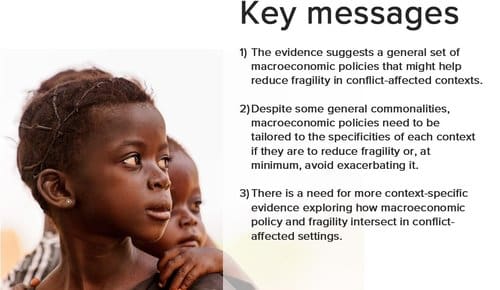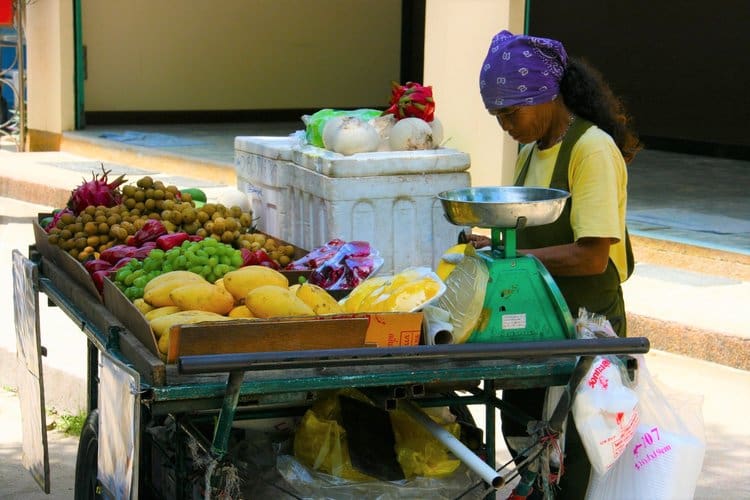A Review of the Evidence
Part 1: Key Messages
This Deetken “Reflections” is one of a series of four posts exploring the intersections between macroeconomic policy and fragility in countries affected by violent conflict. This series builds on work that Deetken undertook on behalf of The World Bank and the United Nations and that involved a review of over 100 sources and interviews with 10 prominent experts. In this post, we summarize the key messages emerging from the evidence we reviewed. In our subsequent posts, we provide a deeper dive into the main findings from our work on our core themes: natural resource revenue management; tax policy; and monetary and exchange rate policy.
If you were to ask most people with an interest in politics or economics if there is a relationship between how a country’s economy is managed and how that country recovers from or avoids violent conflict, the answer would most likely be “yes”. But if you dig a bit deeper and ask how this relationship works in practice or what evidence there is to support it, you may get a less confident response.

As a team of economists, political scientists and data scientists, Deetken was particularly interested in exploring the relationship between macroeconomic policies and fragility in countries affected by violent conflict. We wanted to know what the literature and the experts were saying about how to “do macroeconomics differently” to reduce or mitigate fragility in conflict-affected contexts.
The scope of this type of study is potentially enormous. As a starting point, we focused on three main themes:
- The management of natural resource revenues and linkages to fragility in conflict-affected contexts;
- The impact of tax policy on fragility in conflict-affected contexts; and
- The impact of monetary and exchange rate policy on fragility in conflict-affected contexts.
Key messages
In the course of our research, we identified three key messages regarding the intersection between macroeconomic policy and conflict:
Message 1: The evidence suggests a general set of macroeconomic policies that might help reduce fragility in conflict-affected contexts.
Conflict-affected situations are often characterized by challenging security, political and economic environments. For example, capital flight and inflation may emaciate already thin financial markets. Volatile financial flows and diminishing money demand may put pressure on exchange rates. Supply side shocks in economies dominated by agriculture or natural resource exports may confront policy- makers with trade-offs between inflation and output objectives. Governments in conflict-affected contexts may face large informal and agricultural sectors, a contracted tax base and relatively low revenue. Furthermore, infrastructure and public services may be limited and institutional, administrative, technological and statistical capacities may be weak. In addition, depending on the nature of the conflict, there may be a lack of trust and confidence in the state and/or other groups in society and a lack of political consensus around post-conflict governance priorities.
While every country faces a unique and nuanced situation, these common general characteristics may form the basis for an evidence-based set of macroeconomic policy ideas that might contribute to broader efforts to prevent violent conflict. Let’s take a look, for example, at natural resource revenue management. If well-managed, natural resource revenues can have real peace-related benefits. While there is no single combination of policies or tools related to resource management that will work in every case, there is a general consensus around a number of guiding principles. These include the need for: 1) commitments to anti-corruption and the establishment of mechanisms to combat corruption around revenue management; 2) commitments to transparency and the establishment of mechanisms to ensure transparency of revenue management; 3) commitments and capacities to deliver on good governance principles to guide revenue management; and 4) political will on the part of all key stakeholders to deliver on commitments and to adhere to agreements around revenue management.
Our review of the literature and our interviews uncovered evidence to support other policy ideas in conflict-affected contexts. These include, among a number of other ideas, the following:
1) Well-designed tax policy can contribute to state-building, improved governance, peacebuilding, and political and economic stability. It can help generate adequate, appropriate, sustainable and predictable revenue; enhance the legitimacy of the state and signal the population’s “buy in” with respect to the government’s agenda; improve state-society relations; build capacities; extend state authority; and address horizontal inequalities.
2) Reductions in government expenditure (e.g. fuel subsidy reform) should be designed and timed to mitigate and offset domestic impacts.
3) Fixed and managed exchange rate regimes appear to be preferable to free floating currencies since they help to avoid excessive exchange volatility and may be used to promote exports.
4) Monetary policy might tolerate a higher rate of inflation while still focusing on avoiding and combating hyper-inflationary episodes.

Message 2: Despite some general commonalities, macroeconomic policies need to be tailored to the specificities of each context if they are to reduce fragility or, at minimum, avoid exacerbating it.
While the broad common characteristics of conflict-affected situations might lead to a general set of policy ideas, their application would require careful consideration of the realities of each context. For example, the effectiveness of natural resource revenue-sharing regimes in helping to address conflict mechanisms depends on a variety of factors, including the causes of conflict; the type of resource and its role in the conflict; the strength of domestic institutions and the regulatory/legal environment in which they operate; the internal and external power relations, interests and incentives at play in a particular context; the degree of political commitment, including to anti-corruption and transparency; and regional dynamics and international markets, among other factors.
As another example, the type of tax regime best suited to a fragile context depends on conflict dynamics and divisions within society, a country’s tax culture and history, how tax bargaining works, the influence of external actors, the existence of non-tax revenue sources, and the impact of aid on the domestic tax effort, among many other contextual factors.
Message 3: There is a need for more context-specific evidence exploring how macroeconomic policy and fragility intersect in conflict-affected settings.
The intersections between macroeconomic policy, fragility and conflict is a relatively new and under-researched focus in the literature. A possible reason for the relative lack of research in conflict-affected contexts is the diverse typology of fragility and conflict. It is challenging to test the relationship between macroeconomic variables and political contexts generally when those contexts differ so markedly. There is a general sense that cross-country statistical analysis may not be the best approach to study macroeconomic policy in fragile contexts. Case studies, qualitative analysis, including – in some cases – micro-analysis of individuals and households, and within-country comparisons that consider policy changes or macroeconomic shocks are important complementary approaches to support the ongoing development of an evidence base around the relationships between macroeconomics and fragility in conflict-affected contexts.

Click to read the second in the series, “Natural Resource Revenue Management in Conflict-Affected Contexts,” the third in the series, “Tax Policy and Fragility in Conflict-Affected Contexts” and the final in the series, “Monetary and Exchange Rate Policy in Conflict-Affected Contexts”.


